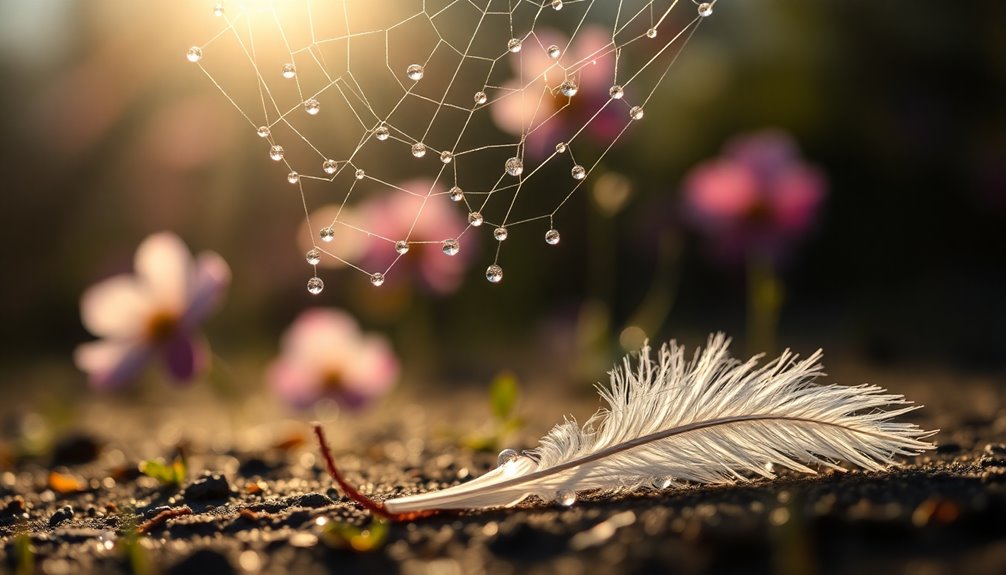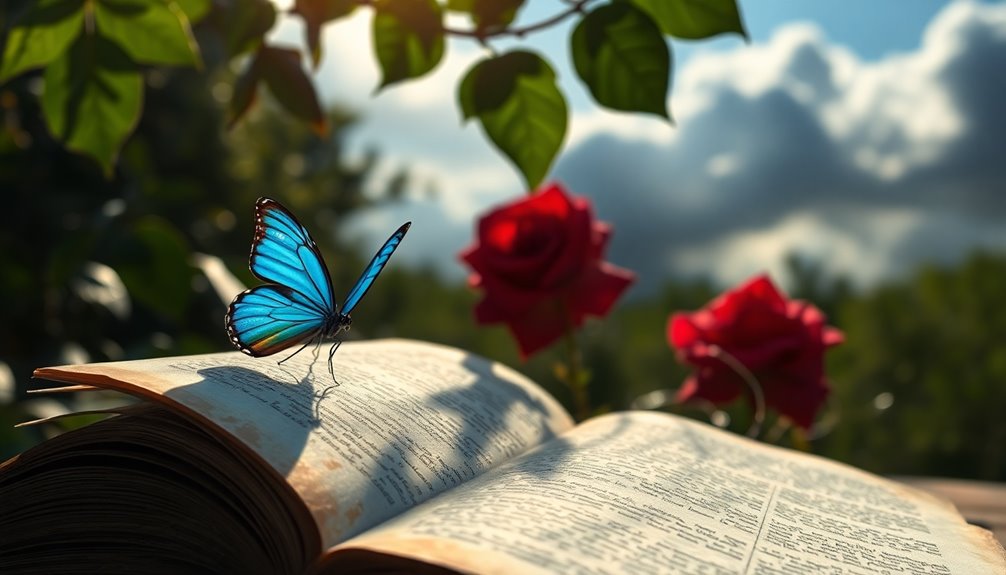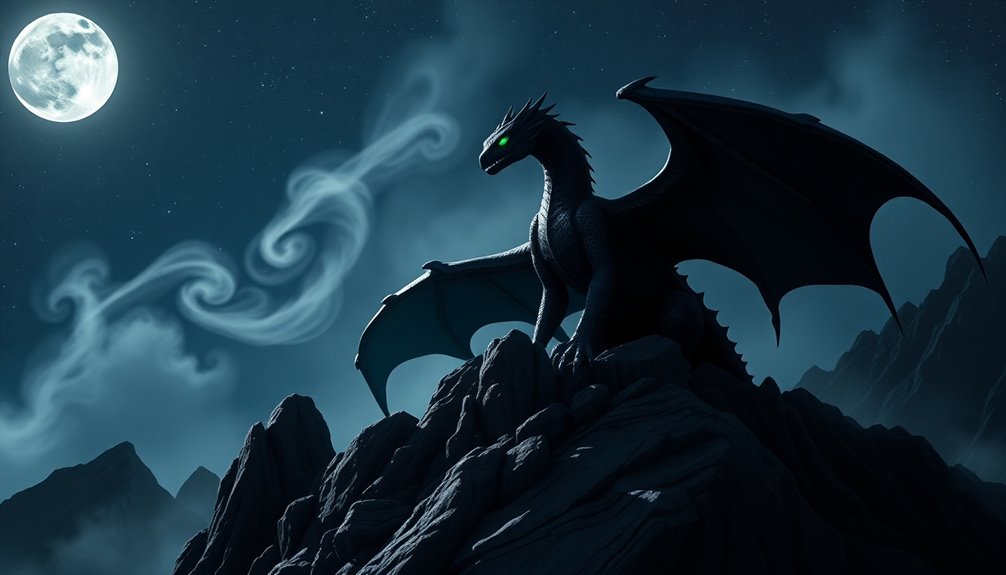Symbolism in literature helps you find deeper meanings behind characters, objects, and events. It's like a treasure hunt for emotions and ideas! For example, in "The Great Gatsby," the green light represents hopes and dreams that seem out of reach. In "The Scarlet Letter," the letter "A" changes from a mark of shame to a symbol of strength. You'll also find symbols everywhere—like wedding rings, which show eternal love, or the color red, which can symbolize passion or danger. Each symbol adds richness to the story, making characters and themes more interesting. Keep exploring to discover even more amazing examples!
Key Takeaways
- Symbolism is a literary device where objects or events represent larger ideas, enhancing the narrative's depth and meaning.
- In "The Great Gatsby," the green light symbolizes Gatsby's unattainable dreams and aspirations.
- The letter "A" in "The Scarlet Letter" evolves from a mark of shame to a symbol of strength and identity.
- In poetry, the raven in Edgar Allan Poe's work symbolizes death and loss, enriching emotional resonance.
- Everyday symbols, like wedding rings, represent love and commitment through their circular shape, conveying deeper meanings in daily life.
Definition of Symbolism

Have you ever wondered how authors convey complex ideas without explicitly stating them? One powerful tool they use is symbolism. Symbolism is a literary device where objects, characters, or events represent larger ideas or concepts. This allows you to discover deeper meanings hidden in the text.
For example, in F. Scott Fitzgerald's "The Great Gatsby," the green light symbolizes unattainable dreams and aspirations. Similarly, Nathaniel Hawthorne's "The Scarlet Letter" uses the letter "A" to represent sin and societal judgment.
Color symbolism is another fascinating aspect. Colors can carry strong meanings; for instance, black often symbolizes death or evil, while white represents purity and innocence. These choices enhance the emotional depth of stories.
Authors use symbolism in various ways, like metaphors and allegories. In George Orwell's "Animal Farm," the entire story serves as an allegory, extending those comparisons throughout the narrative.
Understanding symbolism means looking beyond surface-level interpretations. Symbols can vary in significance, inviting you to engage critically with the text.
Importance of Symbolism

Symbolism plays an essential role in literature, enriching narratives by allowing authors to express complex ideas and emotions through powerful imagery. By using symbols, writers can create deeper connections with you, the reader.
The importance of symbolism lies in its ability to engage you on different levels. When you encounter symbols used in a story, you're encouraged to think critically and explore themes beyond what's just on the surface.
For example, a green light in "The Great Gatsby" represents something significant—unattainable dreams and hope for the future. This kind of literary device helps you feel the characters' struggles and aspirations.
Symbols can also tackle sensitive topics by hiding deeper meanings in simple objects, making the message more impactful.
When you recognize and analyze these examples of a symbol, you gain insight into the author's intent and how you interpret the story. This creates layers of meaning that make reading more exciting.
Types of Symbolism

Let's explore the exciting world of symbolism!
You'll find two main types: metaphors, which compare different things to reveal deeper meanings, and allegories, where entire stories represent big ideas.
Plus, you'll discover how both physical and abstract symbols can bring extra layers of meaning to your favorite books!
Metaphors and Allegories
While exploring literature, you'll often encounter metaphors and allegories, two powerful types of symbolism that deepen your understanding of themes and emotions.
Metaphors are like magic bridges, connecting dissimilar things to reveal deeper meanings. For example, when someone says, "Time is a thief," it suggests that time steals precious moments from our lives. Isn't that interesting?
On the other hand, allegories stretch these ideas throughout entire stories. They allow authors to share complex ideas and moral lessons. A great example is George Orwell's "Animal Farm," where farm animals represent different aspects of society, critiquing totalitarianism.
In many literary works, metaphors evoke emotions and create vivid imagery. Think of Shakespeare's phrase, "All the world's a stage." It paints a picture of life as a theatrical performance.
Similarly, Nathaniel Hawthorne's "The Scarlet Letter" uses the letter "A" as a powerful symbol of sin, guilt, and societal judgment.
Physical and Abstract Symbols
Symbols enrich literature by connecting physical objects and abstract concepts, enhancing the reader's experience.
You'll find that physical symbols often include items like colors or objects that stand for deeper meanings. For instance, in *The Great Gatsby*, the color green serves as an important symbol of unattainable dreams. It's a great example of how a simple color can hold such powerful significance!
On the other hand, abstract symbols convey emotions or themes. Think about Edgar Allan Poe's raven, which symbolizes death and loss. This creates a strong emotional impact on readers.
Other common physical symbols include the rose, representing love and beauty, and the skull, which symbolizes mortality.
Characters can also act as symbols, like the pigs in *Animal Farm*, who symbolize the corruption of power.
Even seasons can hold symbolic meanings, with spring representing new beginnings and winter often symbolizing endings.
Common Literary Symbols

Let's explore some common symbols you'll find in literature!
Colors like black and white can show us deep emotions, while objects like roses and chains tell stories about love and struggle.
Plus, different seasons and animals add even more layers, helping you understand characters and themes better!
Color Symbolism in Literature
Color symbolism in literature enriches narratives by evoking specific emotions and ideas, allowing readers to connect more deeply with the text. Authors often rely on colors to convey feelings and themes in a powerful way.
For instance, in *The Great Gatsby*, the green light shines brightly, symbolizing Gatsby's dreams and hopes for the future. It makes you think about the things you long for, too!
In *The Scarlet Letter*, Nathaniel Hawthorne uses red to represent sin and passion. This color is tied to Hester Prynne's scarlet letter "A," making you feel the weight of her choices.
Black often symbolizes death or evil in stories, like in Shakespeare's *Macbeth*, where dark imagery hints at tragedy and moral decay. You can almost sense the foreboding atmosphere!
On the other hand, blue can evoke a sense of calm or sadness. In *The Catcher in the Rye*, Holden Caulfield reflects on his feelings, often linked to shades of blue, showing his inner struggles.
Object Symbolism Examples
Literature often utilizes common objects to convey deeper meanings and themes, enhancing the reader's understanding of characters and their journeys. For instance, a rose is often used to symbolize romance and beauty. It reflects the complexities of love and desire.
Similarly, chains can represent bondage or connection. They signify the struggles between freedom and restraint in a character's life.
Another great example is the ladder, which frequently symbolizes ascension, growth, or spiritual connection. It highlights a character's journey toward enlightenment or success.
In *The Great Gatsby*, the green light symbolizes Gatsby's unattainable dreams and hopes for the future. This is an obvious symbolism that illustrates the theme of the elusive American Dream.
Finally, letters can carry deep meanings too. In Nathaniel Hawthorne's *The Scarlet Letter*, the scarlet letter "A" signifies identity, sin, and societal judgment. It evolves throughout the story, showing how characters change.
These objects enrich stories and connect readers to the characters' experiences. So next time you read, pay attention to these symbols—they add layers of meaning to the narrative!
Seasonal Symbolism Insights
Seasonal symbolism plays an essential role in literature, offering profound insights into characters and themes. Each season tells a unique story, reflecting emotions and changes in life. Let's explore how different seasons symbolize various ideas!
| Season | Symbolism |
|---|---|
| Spring | New beginnings, renewal, and hope. |
| Summer | Warmth, knowledge, and fulfillment. |
| Fall | Aging, maturity, and reflection. |
| Winter | Endings, despair, and isolation. |
In stories, Spring often brings fresh starts. Characters may find hope and growth during this season. Summer shines with warmth and joy, representing the peak of life. But as Fall approaches, you might notice themes of aging and the passage of time, urging characters to reflect on their journey. Finally, Winter can feel cold and lonely, often marking the end of a chapter in a character's life.
These seasonal changes mirror character development, creating a rich backdrop for exploring complex human emotions. So next time you read, pay attention to how the seasons influence the story! You might discover deeper meanings hidden in the words.
Symbolism in Novels

In novels, symbolism enriches the narrative by adding layers of meaning that resonate with readers. It's exciting to see how authors use symbols to represent something deeper! For example, in *The Great Gatsby*, the green light symbolizes Gatsby's unreachable dreams and hopes for the future. Isn't that fascinating?
In *The Scarlet Letter*, the letter "A" starts as a mark of shame but grows to represent Hester Prynne's strength and identity. Similarly, in *Wuthering Heights*, the wild moors symbolize the passionate and tumultuous relationships between characters. Each type of symbolism adds unique depth to these works of literature.
George Orwell's *Animal Farm* is another fantastic example. Here, the farm and its animals symbolize different roles in society, mirroring the Russian Revolution.
Finally, in *A Raisin in the Sun*, a simple potted plant represents the family's hopes and dreams for a better life.
These examples show how symbolism is used in novels to create connections and enrich the reading experience, making every story more meaningful and engaging!
Symbolism in Poetry

Symbolism plays an essential role in poetry, just as it does in novels, enhancing the emotional depth and thematic complexity of the work. Poets use symbolism to represent something deeper, often conveying complex themes and feelings through vivid imagery. This technique helps you connect with the poem on a more personal level.
For example, in Edgar Allan Poe's "The Raven," the raven symbolizes death and loss, creating a dark atmosphere and themes of despair.
William Wordsworth's poem "She Dwelt Among Untrodden Ways" features a violet flower that represents beauty and rarity, reflecting themes of solitude and longing.
Similarly, in Samuel Taylor Coleridge's "The Rime of the Ancient Mariner," the albatross symbolizes good luck and the burden of sin, emphasizing themes of guilt and redemption.
Symbolism in Everyday Life

Every day, you encounter symbols that convey deeper meanings and emotions, often without realizing it. Take the color red, for example. It can symbolize passion, like love on Valentine's Day, or even danger, such as a stop sign.
Speaking of commitment, wedding rings are perfect examples. Their circular shape symbolizes eternity, representing the love and promise shared between partners.
National flags are another fascinating symbol. They reflect a country's identity, values, and history, evoking feelings of pride and unity among citizens. When you see a flag waving, it can make you feel connected to something larger than yourself.
Traffic lights use color symbolism too! The red light means stop, helping keep everyone safe on the road. Green means go, opening up opportunities for movement, while yellow reminds you to be cautious.
Even everyday objects like keys hold significance. They symbolize access and opportunities, representing the potential to reveal new experiences in your life.
Notable Symbolism Examples

Literature is rich with symbols that deepen the meaning of stories and characters, much like the symbols in our daily lives. Take *The Great Gatsby*, for example. The green light at the end of Daisy's dock symbolizes Gatsby's dreams and hopes for the future, representing central themes of longing and the passage of time.
In Nathaniel Hawthorne's *The Scarlet Letter*, the letter "A" starts as a mark of shame for Hester Prynne but evolves into a symbol of her strength and identity.
Similarly, in *Wuthering Heights*, the moors symbolize the wild emotions of the characters and their tumultuous relationships.
Elie Wiesel's *Night* uses the dark symbolism of night itself to reflect despair and loss during the Holocaust, while Lorraine Hansberry's *A Raisin in the Sun* features a plant that embodies the family's hope for a better life despite their struggles.
These examples show how symbolism enriches stories, turning objects and images into powerful extended metaphors. Each symbol invites you to dive deeper, revealing insights into human experiences and emotions.
Frequently Asked Questions
What Is Symbolism in Literature?
Symbolism in literature is when writers use objects, characters, or events to represent bigger ideas or feelings.
Think of it as a secret code! For example, a dove might symbolize peace, while a storm could represent chaos.
These symbols help you connect more deeply with the story. When you spot them, you're not just reading—you're discovering layers of meaning that make the tale even more exciting and thought-provoking!
What Are 5 Examples of Symbolism in Sentences?
Here are five examples of symbolism.
In *The Great Gatsby*, the green light shows Gatsby's dreams.
In *To Kill a Mockingbird*, the mockingbird represents innocence.
The conch shell in *Lord of the Flies* symbolizes order and civilization.
In *The Scarlet Letter*, Hester's "A" changes from shame to strength.
Finally, Moby Dick, the whale, reflects obsession and revenge.
Each symbol adds deeper meaning to the story, making it more exciting!
What Is an Easy Example of Symbolism in Literature?
A great example of symbolism in literature is the green light in *The Great Gatsby*.
It represents Gatsby's dreams and hopes for the future, shining brightly but always out of reach.
When you think about it, that green light captures the feeling of longing we all experience.
It shows how symbols can add deeper meaning to a story, making you think about your own dreams and desires, just like Gatsby does!
What Is One Symbolism in Literature?
Did you know that over 70% of stories use symbolism? It's a fun way to show deeper meanings!
For example, in literature, a simple object can represent big ideas. Think about a key; it might symbolize freedom or new beginnings.
When you read, look for these symbols—they add excitement and layers to the story. They help you connect more with the characters and their journeys, making your reading experience even more enjoyable!
Conclusion
Symbolism in literature is like a treasure map, leading you to deeper meanings and connections. It adds color and vibrancy to stories and poems, making them come alive. When you spot a symbol, you reveal a new layer of understanding. As you immerse yourself in novels or poetry, keep an eye out for these hidden gems. They can turn an ordinary tale into an extraordinary journey. So, explore, discover, and let symbolism spark your imagination!











